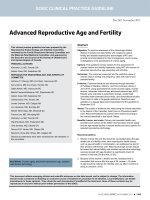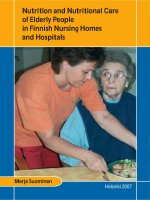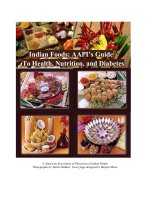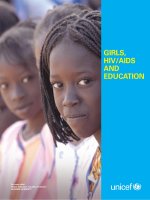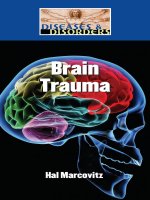SICK! Diseases and Disorders, Injuries and Infections_2 pptx
Bạn đang xem bản rút gọn của tài liệu. Xem và tải ngay bản đầy đủ của tài liệu tại đây (18.02 MB, 274 trang )
SICK!
Diseases and
Disorders,
Injuries and
Infections
Sick.tpgsV4 4/5/04 1:47 PM Page 1
SICK!
Diseases and
Disorders,
Injuries and
Infections
R to Z
volume
4
David Newton,
Donna Olendorf,
Christine Jeryan,
Karen Boyden,
Editors
Sick.tpgsV4 4/5/04 1:47 PM Page 3
Sick!
Diseases and Disorders, Injuries and Infections
David Newton, Donna Olendorf, Christine Jeryan, Karen Boyden, Editors
STAFF
Christine Slovey, U•X•L Editor
Carol DeKane Nagel, U•X•L Managing Editor
Meggin Condino, Senior Analyst, New Product Development
Thomas L. Romig, U•X•L Publisher
Shalice Shah-Caldwell, Permissions Specialist (Pictures)
Rita Wimberley, Senior Buyer
Evi Seoud, Assistant Production Manager
Dorothy Maki, Manufacturing Manager
Mary Beth Trimper, Production Director
Pamela Reed, Imaging Coordinator
Robert Duncan, Imaging Specialist
Randy Basset, Image Database Supervisor
Barbara Yarrow, Graphic Services Manager
Michelle Di Mercurio, Senior Art Director
Cynthia Baldwin, Product Design Manager
GGS Information Services, Inc., Typesetting
Michelle Cadoree, Indexer
Cover illustration by Kevin Ewing Illustrations.
Library of Congress Cataloging-in-Publication Data
Sick! diseases and disorders, injuries and infections/ David E. Newton…[et al.].
p. cm.
Includes bibliographical references and indexes.
Summary: Presents articles describing the causes and symptoms, diagnosis, treatment (both
traditional and alternative), prognosis, and prevention of various diseases, disorders, injuries,
and infections.
ISBN 0-7876-3922-2 (set)
1. Diseases—Encyclopedias, Juvenile. [1. Health—Encyclopedias. 2.Diseases—Encyclope-
dias.] I.Newton, David E.
R130.5 .S53 1999
616’.003–dc21 99-044739
This publication is a creative work fully protected by all applicable copyright laws, as well as by mis-
appropriation, trade secret, unfair competition, and other applicable laws. The editors of this work
have added value to the underlying factual material herein through one or more of the following:
unique and original selection, coordination, expression, arrangement, and classification of the infor-
mation. All rights to this publication will be vigorously defended.
Copyright © 2000 U•X•L, an imprint of the Gale Group
All rights reserved, including the right of reproduction in whole or in part in any form.
Printed in United States of America
10 9 8 7 6 5 4 3 2 1
52573_frontmatter4 12/8/99 8:57 AM Page iv
Contents
Reader’s Guide xi
Words to Know xv
Research and Activity Ideas xlv
VOLUME 1: A–C
Acne
1
Addiction 7
AIDS 14
Alcoholism 25
Allergies 32
Alzheimer’s disease 40
Amyotrophic lateral sclerosis 48
Anemias 53
Anorexia nervosa 61
Appendicitis 67
Arthritis 71
Asthma 78
Atherosclerosis 87
Athlete’s foot 94
Attention-deficit/hyperactivity disorder 97
Autism 103
Autoimmune disorders 110
Bipolar disorder 117
v
52573_frontmatter4 12/8/99 8:57 AM Page v
Breast cancer 123
Bronchitis 128
Bulimia nervosa 135
Burns and scalds 140
Cancer 147
Carpal tunnel syndrome 158
Cateracts 162
Cerebral aneurysm 165
Cerebral palsy 170
Chickenpox 180
Chronic fatigue syndrome 185
Color blindness 191
Colorectal cancer 194
Common cold 199
Concussion 206
Conjunctivitis 211
Creutzfeldt-Jakob disease 215
Crohn’s disease 222
Cystic fibrosis 226
Cystitis 233
VOLUME 2: D–H
Decompression sickness 239
Depressive disorders 244
Diabetes mellitus 251
Down’s syndrome 259
Dyslexia 266
Earache 271
Emphysema 276
Encephalitis 283
Epilepsy 287
Flesh-eating disease 295
Food poisoning 298
Fractures, sprains, strains 309
Frostbite 317
vi
Sick! Diseases and Disorders, Injuries and Infections
contents
52573_frontmatter4 12/8/99 8:57 AM Page vi
Glaucoma 323
Hantavirus infections 329
Hay Fever 333
Head injury 340
Headache 346
Hearing loss 351
Heart attack 355
Heart murmur 363
Heat disorders 367
Hemophilia 371
Hemorrhagic fevers 378
Hepatitis 384
Hernia 391
Herpes infections 395
Hodgkin’s disease 401
Hypertension 406
Hypoglycemia 413
Hypothermia 419
VOLUME 3: I–P
Infectious mononucleosis 423
Influenza 427
Insomnia 434
Irritable bowel syndrome 439
Juvenile arthritis 445
Kaposi’s sarcoma 451
Laryngitis 457
Lead poisoning 460
Learning disorders 467
Leukemia 471
Lice 478
Lung cancer 482
Lupus 487
Lyme disease 492
Malaria 499
Volume Four vii
contents
52573_frontmatter4 12/8/99 8:57 AM Page vii
Measles 505
Meningitis 509
Mental retardation 515
Multiple sclerosis 520
Mumps 529
Muscular dystrophy 534
Obesity 543
Obsessive-compulsive disorder 551
Osteoporosis 558
Panic disorder 565
Parkinson’s disease 571
Periodontal disease 579
Pneumonia 582
Pneumothorax 587
Polio 591
Posttraumatic stress disorder 596
Prostate cancer 601
VOLUME 4: R–Z
Rabies 607
Radiation injuries 612
Reye’s syndrome 620
Rheumatic fever 623
Ringworm 628
Rubella 633
Scarlet fever 639
Schizophrenia 642
Scoliosis 649
Seasonal affective disorder 654
Sexually transmitted diseases 659
Shaken baby syndrome 667
Sickle cell anemia 670
Skin cancer 677
Skin disorders 683
Sleep disorders 690
viii
Sick! Diseases and Disorders, Injuries and Infections
contents
52573_frontmatter4 12/8/99 8:57 AM Page viii
Smallpox 697
Smoke inhalation 701
Sore throat 706
Spina bifida 711
Spinal cord injury 716
Strep throat 723
Stroke 727
Sudden infant death syndrome 734
Tay-Sachs disease 741
Temporomandibular joint disorder 745
Tendinitis 748
Tetanus 752
Tonsillitis 756
Tooth decay 760
Tourette syndrome 765
Toxic shock syndrome 769
Tuberculosis 773
Ulcerative colitis 781
Ulcers (digestive) 786
Vision disorders 793
Warts 801
Whiplash 807
Whooping cough 809
Bibliography xlix
Index li
Volume Four ix
contents
52573_frontmatter4 12/8/99 8:57 AM Page ix
Reader’s Guide
Sick! Diseases and Disorders, Injuries and Infections presents the latest in-
formation on 140 wide-ranging illnesses, disorders, and injuries. Included
are entries on familiar medical problems readers might encounter in daily
life, such as acne, asthma, chickenpox, cancer, and learning disorders. Some
rare and fascinating illnesses are covered as well, such as smallpox, han-
taviruses, and Creutzfeld Jakob disease (also known as mad cow disease).
Entries are arranged alphabetically across the four-volume set and gen-
erally range from three to eight pages in length. Each entry provides the de-
tails students need for reports and other health-related assignments under
the following standard subheads: definition, description, causes, symptoms,
diagnosis, treatment, prognosis, and prevention.
A “Words to Know” box included at the beginning of each entry pro-
vides definitions of words and terms used in that entry. Sidebars highlight
interesting facts and individuals associated with the medical condition dis-
cussed. At the end of each entry, under the heading “For More Information,”
appears a list of sources for further information about the disease. The set
has approximately 240 black-and-white photos. More than 80 images appear
in color in an insert in each volume.
Each volume of Sick! begins with a comprehensive glossary collected from
all the “Words to Know” boxes in the entries and a selection of research and
activity ideas. Each volume ends with a general bibliography section listing
comprehensive sources for studying medical conditions and a cumulative in-
dex providing access to all major terms and topics covered throughout Sick!
xi
52573_frontmatter4 12/8/99 8:57 AM Page xi
Related Reference Sources
Sick! is only one component of the three-part U•X•L Complete Health
Resource. Other titles in this library include:
• Body by Design: This two-volume set presents the anatomy (structure) and
physiology (function) of the human body in twelve chapters spread over
two volumes. Each chapter is devoted to one of the eleven organ systems
that make up the body. The last chapter focuses on the special senses, which
allow humans to connect with the real world. Sidebar boxes present his-
torical discoveries, recent medical advances, short biographies of scientists,
and other interesting facts. More than 100 photos, many of them in color,
illustrate the text.
• Healthy Living: This three-volume set examines fitness, nutrition, and other
lifestyle issues across fifteen subject chapters. Topics covered include hy-
giene, mental health, preventive care, alternative medicine, and careers in
health care. Sidebar boxes within entries provide information on related is-
sues, while over 150 black-and-white illustrations help illuminate the text.
Acknowledgments
A note of appreciation is extended to U•X•L’s Complete Health Resource
advisors, who provided invaluable suggestions when this work was in its for-
mative stages:
Carole Branson
Seminar Science Teacher
Wilson Middle School
San Diego, California
Bonnie L. Raasch
Media Specialist
Vernon Middle School
Marion, Iowa
Doris J. Ranke
Science Teacher
West Bloomfield High School
West Bloomfield, Michigan
Comments and Suggestions
We welcome your comments on Sick! Diseases and Disorders, Injuries and In-
fections. Please write: Editors, Sick!, U•X•L, 27500 Drake Rd., Farmington Hills,
Michigan 48331–3535; call toll free: 1–800–877–4253; fax: 248–414–5043; or
send e-mail via .
xii Sick! Diseases and Disorders, Injuries and Infections
reader’s guide
52573_frontmatter4 12/8/99 8:57 AM Page xii
Please Read: Important
Information
Sick! Diseases and Disorders, Injuries and Infections is a medical reference
product designed to inform and educate readers about medical conditions.
U•X•L believes this product to be comprehensive, but not necessarily de-
finitive. While U•X•L has made substantial efforts to provide information
that is accurate and up to date, U•X•L makes no representations or war-
ranties of any kind, including without limitation, warranties of mer-
chantability or fitness for a particular purpose, nor does it guarantee the ac-
curacy, comprehensiveness, or timeliness of the information contained in this
product.
Readers should be aware that the universe of medical knowledge is con-
stantly growing and changing, and that differences of medical opinion exist
among authorities. They are also advised to seek professional diagnosis and
treatment for any medical condition, and to discuss information obtained
from this book with their health care provider.
xiii
52573_frontmatter4 12/8/99 8:57 AM Page xiii
Words to Know
Diseases that are featured as main entries in Sick! are not covered in Words
to Know.
A
Abortive: Describes an action that cuts something short or stops it.
Abscess: A pocket of infection within tissue.
Accommodation: The ability of the lens of the eye to change its shape in or-
der to focus light waves from distant or near objects.
Acetylsalicylic acid: The chemical name for the primary compound from
which aspirin is made. Shorthand terms for acetylsalicylic acid include acetyl-
salicylate, salicylic acid, and salicylate.
Acute: A disorder that comes on suddenly and usually does not last very
long.
Acute retroviral syndrome: A group of symptoms resembling mononucle-
osis that are the first sign of HIV infection in 50 to 70 percent of all patients
and in 45 to 90 percent of women.
Adenoid: A mass of lymph tissue located near the pharynx.
Adenoviruses: A group of viruses that usually cause infections of the lungs
and ears.
African endemic Kaposi’s sarcoma: A form of Kaposi’s sarcoma that affects
boys and men, has symptoms like those of classic Kaposi’s sarcoma, and can
spread rapidly and cause death.
Agoraphobia: A fear of open spaces.
xv
52573_frontmatter4 12/8/99 8:57 AM Page xv
AIDS dementia complex: A type of brain dysfunction caused by HIV infection
that causes confusion, difficulty thinking, and loss of muscular coordination.
AIDS-related Kaposi’s sarcoma: A form of Kaposi’s sarcoma that occurs pri-
marily in gay and bisexual men; it is much more dangerous than classic Ka-
posi’s sarcoma.
Allergen: A substance that provokes an allergic response.
Allergic reaction: A series of events initiated by the immune system against
substances that are normally harmless to the body.
Alveoli: Small air sacs at the ends of bronchioles through which oxygen
passes from the lungs into blood.
Amalgam: A mixture of mercury, silver, and other metals used to make fill-
ings for dental cavities.
Amenorrhea: Absence of menstrual periods.
Amnesia: Loss of memory sometimes caused by a brain injury, such as a
concussion.
Amniocentesis: A medical procedure in which a sample of the fluid sur-
rounding the fetus in a woman’s womb is withdrawn and examined.
Amputation: A surgical procedure in which an arm, leg, hand, or foot is re-
moved.
Anaphylaxis: An increased sensitivity to an allergen causing dilation (ex-
pansion) of blood vessels and tightening of muscles. Anaphylaxis can result
in sharp drops in blood pressure, difficulty in breathing, and death if left un-
treated.
Androgen: A male sex hormone found in both males and females.
Anemia: A medical condition caused by a reduced number of red blood cells
and characterized by general weakness, pale skin color, irregular heartbeat,
shortness of breath, and fatigue.
Aneurysm: A weak spot in a blood vessel that may break open and lead to
a stroke.
Angiography: A method for studying the structure of blood vessels by in-
serting a catheter into a vein or artery, injecting a dye in the blood vessel,
and taking X-ray photographs of the structure.
Anti-androgen: A drug that slows down the production of androgens.
Antibiotic: A substance derived from bacteria or other organisms that fights
the growth of other bacteria or organisms.
Antibody: Specific protein produced by the immune system to destroy spe-
cific invading organisms.
xvi Sick! Diseases and Disorders, Injuries and Infections
words to know
52573_frontmatter4 12/8/99 8:57 AM Page xvi
Anticoagulant: Describes a substance that prevents the blood from clotting.
Anticonvulsant medication: A drug used to prevent convulsions or seizures
that is sometimes also effective in the treatment of bipolar disorder.
Antidepressant: A drug used to prevent or relieve depression.
Antigen: Any substance that stimulates the body to produce antibodies.
Antioxidant: A substance that prevents oxidation from taking place. Oxida-
tion is a chemical reaction that can create heat, pain, and inflammation in
the body.
Anxiety: Feeling troubled, uneasy, or worried.
Anxiety disorder: An experience of prolonged, excessive worry about the
circumstances of one’s life.
Aplastic: Having incomplete or faulty development.
Apnea: A temporary pause in one’s breathing pattern. Sleep apnea consists
of repeated episodes of temporary pauses in breathing during sleep.
Appendectomy: Surgical removal of the appendix.
Appendix: The worm-shaped pouch near the beginning of the large intestine.
Appetite suppressant: Drugs that decrease feelings of hunger and control
appetite.
Aqueous humor: A watery fluid that fills the inside of the eyeball, provid-
ing nourishment to the eye and maintaining internal pressure in the eyeball.
Arteries: Blood vessels that carry blood from the heart to organs and tissues
of the body.
Arteriosclerosis: Hardening of the arteries that can be caused by a variety
of factors. Atherosclerosis is just one form of arteriosclerosis, but the two
terms are often used interchangeably.
Artery: A blood vessel that carries blood from the heart to other parts of the
body.
Arthrography: An imaging technique in which a dye is injected into a joint
to make X-ray pictures of the inside of the joint easier to study.
Asperger syndrome: A type of autism that involves no problems with lan-
guage.
Aspiration: Inhalation of food or saliva.
Astigmatism: A condition in which light from a single point fails to focus
on a single point of the retina. The condition causes the patient to see a
blurred image.
Volume Four xvii
words to know
52573_frontmatter4 12/8/99 8:57 AM Page xvii
Ataxia: A condition in which balance and coordination are impaired.
Athetonia: A condition marked by slow, twisting, involuntary muscle
movements.
Atopy: A condition in which people are more likely to develop allergic re-
actions, often because of the inflammation and airway narrowing typical of
asthma.
Atrium: (plural: atria) One of the two upper chambers of the heart.
Audiometer: An instrument for testing a person’s hearing.
Auditory nerve: A bunch of nerve fibers that carries sound from the inner
ear to the brain.
Auditory canal: A tube that leads from the outside of the ear to the tym-
panic membrane.
Auricle: The external structure of the ear.
Autoimmunity: A condition in which the body’s immune system produces
antibodies in response to its own tissues or blood components instead of for-
eign particles or microorganisms.
Autonomic responses: Bodily responses that occur automatically, without
the need for a person to think about it.
Autopsy: A medical examination of a dead body.
B
Bacillus Calmette-Guérin (BCG): A vaccine made from a weakened my-
cobacterium that infects cattle. It is used to protect humans against pulmonary
tuberculosis and its complications.
Barium enema: A procedure in which a white liquid is injected into a pa-
tient’s rectum in order to coat the lining of the colon so that X-ray pho-
tographs of the colon can be taken.
Becker muscular dystrophy (BMD): A type of muscular dystrophy that af-
fects older boys and men and usually follows a milder course than Duchenne
muscular dystrophy (DMD).
Benign: A growth that does not spread to other parts of the body, making
recovery likely with treatment. Often used to describe noncancerous growths.
Binge: To consume large amounts of food without control in a short period
of time.
Biofeedback: A technique in which a person learns to consciously control
the body’s response to a stimulus. Biofeedback enables a person to gain some
control over involuntary body functions.
xviii Sick! Diseases and Disorders, Injuries and Infections
words to know
52573_frontmatter4 12/8/99 8:57 AM Page xviii
Biopsy: A procedure in which a small sample of tissue is removed and then
studied under a microscope.
Blind spot: An area on the retina that is unable to respond to light rays.
Blood-brain barrier: A network of blood vessels between the neck and the
brain that prevents many chemicals from passing into the brain.
Bone marrow: Soft, spongy material found in the center of bones from which
blood cells are produced.
Bone marrow biopsy: A procedure by which a sample of bone marrow is
removed and studied under a microscope.
Bone marrow transplantation: A process by which marrow is removed from
the bones of a healthy donor and transferred to the bones of a person with
some kind of blood disorder.
Bortadella pertussis: The bacterium that causes whooping cough.
Brain stem: A mass of nervous tissue that connects the forebrain and the
cerebrum to the spinal cord.
Bronchi: Two large tubes that branch off the trachea and lead to the lungs;
each tube is called a bronchus when referred to singularly. Also called
bronchial tubes.
Bronchial tubes: Another name for bronchi. The major airways that lead to
the lungs.
Bronchioles: Smaller extensions of the bronchi.
Bronchodilator: A substance that causes muscles in the respiratory system
to relax, making breathing easier.
Bronchoscope: A device consisting of a long thin tube with a light and cam-
era on the end for looking into a patient’s airways and lungs.
BSA: Refers to “body surface area,” a unit used in the treatment of burns to
express the amount of the total body surface area covered by the burn.
C
C. botulinum: A very deadly bacteria that causes a disease known as botulism.
Calcium: An essential mineral with many important functions in the body,
one of which is in the formation of bone.
Campylobacter jejuni (C. jejuni): A bacteria that is the leading cause of bac-
terial diarrhea in the United States. It occurs in healthy cattle, chickens, birds,
and flies.
Carcinogen: Any substance capable of causing cancer.
Volume Four xix
words to know
52573_frontmatter4 12/8/99 8:57 AM Page xix
Cardiovascular: A term that refers to the heart and blood system.
Carditis: Inflammation of the heart.
Caries: The medical term for tooth decay.
Carpal tunnel: A passageway in the wrist, created by bones and ligaments,
through which the median nerve passes.
Carrier: A person whose body contains the organisms that cause a disease
but who does not show symptoms of that disease.
Cartilage: Tough, elastic tissue that covers and protects the ends of bones.
Cataplexy: A sudden loss of muscular control that may cause a person to
collapse.
Catatonic behavior: Behavior characterized by muscular tightness or rigid-
ity and lack of response to the environment.
Catheter: A thin tube inserted into the patient’s body, often into a vein or
artery, to allow fluids to be sent into or taken out of the body.
Cavity: In dentistry, a hole or weak spot in tooth enamel caused by decay.
CD4: A type of protein molecule in human blood that is present on the sur-
face of 65 percent of immune cells. The HIV virus infects cells that have CD4
surface proteins, and as a result, depletes the number of T cells, B cells, nat-
ural killer cells, and monocytes in the patient’s blood. Most of the damage to
an AIDS patient’s immune system is done by the virus’s destruction of CD4
lymphocytes.
Central nervous system: A system of nerve cells in the brain and the spinal
cord.
Cephalosporin: A specific type of antibiotic used to treat many types of in-
fections.
Cerebral thrombosis: Blockage of a blood vessel in the brain by a blood clot
that formed in the brain itself.
Cerebral edema: Swelling of the brain caused by an accumulation of fluid.
Cerebral embolism: Blockage of a blood vessel in the brain by a blood clot
that originally formed elsewhere in the body and then traveled to the brain.
Cerebrospinal fluid (CSF): Fluid made in chambers of the brain that flows
over the surface of the brain and the spinal cord. CSF provides nutrients to
cells of the nervous system and provides a cushion for the structures of the
nervous system. It is often used to diagnose infections of the central nervous
system (the brain and spinal cord).
Cerumen: Earwax.
xx Sick! Diseases and Disorders, Injuries and Infections
words to know
52573_frontmatter4 12/8/99 8:57 AM Page xx
Cervical traction: The process of using a mechanism to create a steady pull
on the neck in order to keep it in the correct position while it heals.
CFTR: An abbreviation for cystic fibrosis transmembrane conductance reg-
ulator, a chemical that controls the amount of water in mucus.
Chelation therapy: Treatment with chemicals that bind to a poisonous metal
and help the body quickly eliminate it.
Chemotherapy: A method of treating cancer using certain chemicals that can
kill cancer cells.
Child abuse: Intentional harm done to infants and children, usually by par-
ents or care givers.
Chlamydia: A family of microorganisms that causes several types of sexually
transmitted diseases in humans.
Chloroquine: An antimalarial drug first used in the 1940s as a substitute for
quinine, and still widely used in Africa because of its relatively low cost.
Cholesterol: A waxy substance produced by the body and used in a variety
of ways.
Chorea: Involuntary movements that may cause the arms or legs to jerk about
uncontrollably.
Chromosome: A structure located inside the nucleus (center) of a cell that
carries genetic information.
Chronic: Recurring frequently or lasting a long time.
Cilia: Fine, hair-like projections that line the trachea and bronchi. Cilia wave
back and forth, carrying mucus through the airways and clearing the airways
of foreign materials.
Circadian rhythm: Any body pattern that follows a twenty-four-hour cycle,
such as waking and sleeping.
Circumcision: The procedure in which the foreskin is removed from the
penis.
Cirrhosis: A liver disorder caused by scarring of liver tissue.
Classic Kaposi’s sarcoma: A form of Kaposi’s sarcoma that usually affects
older men of Mediterranean or eastern European background.
Clostridium tetani: The bacterium that causes tetanus.
Clonic phase: The stage of a grand mal seizure in which muscles alternately
contract and relax.
Clotting factor: One of the chemicals necessary for blood clotting.
Volume Four xxi
words to know
52573_frontmatter4 12/8/99 8:57 AM Page xxi
Cobb angle: A measure of the curvature of the spine, determined from mea-
surements made on X-ray photographs.
Cognitive-behavioral therapy: A form of psychological counseling in which
patients are helped to understand the nature of their disorder and reshape
their environment to help them function better.
Colonoscopy: A procedure in which a long, thin tube is inserted through a
patient’s rectum into the colon to permit examination of the inner walls of
the colon.
Colostomy: An opening created surgically that runs from the colon to the
outside of the body to provide an alternative route for the evacuation of body
wastes.
Comedo: A hard plug composed of sebum and dead skin cells that devel-
ops in the pores of the skin. The mildest form of acne.
Comedolytic: Drugs that break up comedos and open clogged pores.
Compulsion: A very strong urge to do or say something that usually cannot
be resisted and is repeated again and again.
Computed tomography (CT) scan: A technique in which X-ray photographs
of a particular part of the body are taken from different angles. The pictures
are then fed into a computer that creates a single composite image of the in-
ternal (inside) part of the body. CT scans provide an important tool in the
diagnosis of brain and spinal disorders, cancer, and other conditions.
Computerized axial tomography (CAT) scan: Another name for a com-
puted tomography (CT) scan.
Condom: A thin sheath (covering) worn over the penis during sexual activ-
ity to prevent pregnancy and the spread of sexually transmitted diseases.
Conduct disorder: A behavioral and emotional disorder of childhood and
adolescence. Children with a conduct disorder act inappropriately, infringe
on the rights of others, and violate social rules.
Conductive hearing loss: Hearing loss that occurs in the external or mid-
dle ear.
Cone cells: Special cells in the retina responsible for color vision.
Congenital disorder: A medical condition that is present at birth.
Contact dermatitis: Inflammation of the skin caused by exposure to an
allergen.
Contracture: A permanent shortening and tightening of a muscle or tendon
causing a deformity.
xxii Sick! Diseases and Disorders, Injuries and Infections
words to know
52573_frontmatter4 12/8/99 8:57 AM Page xxii
Contrast hydrotherapy: A procedure in which a series of hot- and cold-
water applications is applied to an injured area.
Contusion: A bruise.
Cornea: The transparent outer coating on the front of the eyeball.
Coronary: Referring to the heart.
Coronavirus: A type of virus that can cause the common cold.
Coxsackie virus: A virus that causes a disease known as herpangina.
Crabs: A slang term for pubic lice.
Crib death: Another name for sudden infant death syndrome.
Cryosurgery: The use of liquid nitrogen for the purpose of removing dis-
eased tissue.
Cyanosis: A condition that develops when the body does not get enough
oxygen, causing the skin to turn blue.
D
Debridement: The surgical removal of dead skin.
Decompression stops: Stops divers should make when returning to the sur-
face to let the nitrogen in their blood dissolve safely out of their bodies. Charts
developed by the U.S. Navy and other groups list the number of stops and
the time to be spent at each stop.
Delusion: A fixed, false belief that is resistant to reason or factual disproof.
Dementia: Impaired intellectual function that interferes with normal social
and work activities.
Densitometry: A technique for measuring the density of bone by taking pho-
tographs with low-energy X rays from a variety of angles around the bone.
Dentin: The middle layer of a tooth.
Dependence: A state in which a person requires a steady amount of a par-
ticular drug in order to avoid experiencing the symptoms of withdrawal.
Depot dosage: A form of medication that can be stored in the patient’s body
for several days or weeks.
Depression: A psychological condition with feelings of sadness, sleep dis-
turbance, fatigue, and inability to concentrate.
Detoxification: The phase of treatment during which a patient gives up a
substance and harmful chemicals are removed from his or her system.
Volume Four xxiii
words to know
52573_frontmatter4 12/8/99 8:57 AM Page xxiii
Diaphragm: As a form of birth control, a thin rubber cap inserted into the
vagina.
Diastolic blood pressure: Blood pressure exerted by the heart when it is
resting between beats.
Digital rectal examination: A medical procedure in which a doctor inserts
a lubricated gloved finger into the rectum to look for abnormal structures.
Dimercaprol (BAL): A chemical agent used in chelation therapy.
Diopter: The unit of measure used for the refractive (light bending) power
of a lens.
Diplegia: Paralysis of the arm and leg on one side of the body.
Disease reservoir: A population of animals in which a virus lives without
causing serious illness among the animals.
Distal muscular dystrophy (DD): A form of muscular dystrophy that usu-
ally begins in middle age or later, causing weakness in the muscles of the feet
and hands.
Dominant gene: A form of a gene that predominates over a second form of
the same gene.
Dopamine: A neurotransmitter that helps send signals that control movement.
DSM-IV: The Diagnostic and Statistical Manual of Mental Disorders, Fourth Edi-
tion, the standard reference book used for diagnosing and treating mental
disorders.
Duchenne muscular dystrophy (DMD): The most severe form of muscular
dystrophy, usually affecting young boys, beginning in the legs, and resulting
in progressive muscle weakness.
Duodenum: The upper part of the small intestine, joined to the lower part
of the stomach.
Dyslexia: Difficulty in reading, spelling, and/or writing words.
Dysthymic disorder: An ongoing, chronic depression that lasts two or more
years.
Dystonia: Loss of the ability to control detailed muscle movement.
E
Echocardiogram: A test that uses sound waves to produce an image of the
structure of the heart.
ECT: Electroconvulsive shock therapy, a method for using electric shocks to
treat patients with mental disorders, such as bipolar disorder.
xxiv Sick! Diseases and Disorders, Injuries and Infections
words to know
52573_frontmatter4 12/8/99 8:57 AM Page xxiv





